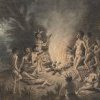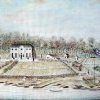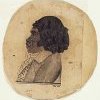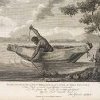1790s
1790
Dawes begins work with Pattyegarang (Patyegarang) at Dawes Point in constructing a Sydney language vocabulary.
McIntyre, the Governor’s gamekeeper, is speared by Pemulwuy, a powerful warrior of the Bidgigal people. Phillip orders a revenge expedition to catch the culprits. They march to Botany Bay, with orders to bring back two men to be executed and the heads of ten more. The Botany Bay people are targeted because Bennelong has suggested that Pemulwuy comes from this area but more probably Pemulwuy’s people are the Bidgigal, the ‘woods tribe’ of the inland Georges River area. A party of fifty soldiers heads to Botany Bay but lose their way in the swamps. They find Coleby who tells them that Pemulwuy has fled long ago to the south. Following the failure of this expedition Phillip sends out another party in December. (Karskens, pp. 392-395)
Until the 1820s, Sydney Koori people stage big fights or dances probably in an area known as the Brickfields, probably near the southern end of what becomes Hyde Park near Liverpool St, that is, the site of the Sydney War Memorial. Fights are also held until at least 1795 at Pannerong, later called Rose Bay. By 1795 other Koori people are coming from ‘the woods’ in western Sydney and from great distances inland. (Karskens p. 441-3)
Women line-fish from small canoes while the men fish with spears and usually on shore. Early colonists and later anthropologists agree that most of the food is gathered by women. Fish and shellfish from the waters, small animals and lizards, and the winter food of fern roots from the ground cleared by summertime burning. For men, the procuring of food really seems to observers, to be of secondary importance to the real business of the day, fighting and contests. Women generally cook the food and share it with small children and babies aboard their canoes. (Karskens, pp. 405-406)
1791
Bennelong and Barangaroo come nearly every day with their two adopted children, to eat at Government House at Circular Quay. A cottage is built for Bennelong near the site of the present Opera House, Bennelong Point. This also becomes an important site for the Sydney peoples’ dances or corroborees. (Karskens, p. 389)
1792
1794
1795
Bennelong returns and by 1797, has been married and has at least one more child, named Dicky. He regains his former authority and is regarded as ‘King of the Natives in the Kissing Point - Eastwood area.’ He officiates in one of the last recorded corrobories in the harbour in 1797. (Karskens, pp. 422-423)
1796
1797
1799
Bondel (usually called Bundle) sails with Nambarry on the Reliance, from Sydney to Norfolk Island. He is again mentioned in 1811 as one of the Aboriginal men who have ‘made themselves extremely useful onboard colonial vessels employed in the fishing and sealing trade, for which they are in regular receipt of wages. (Vincent Smith p. 25)












.thumbnail.JPG)